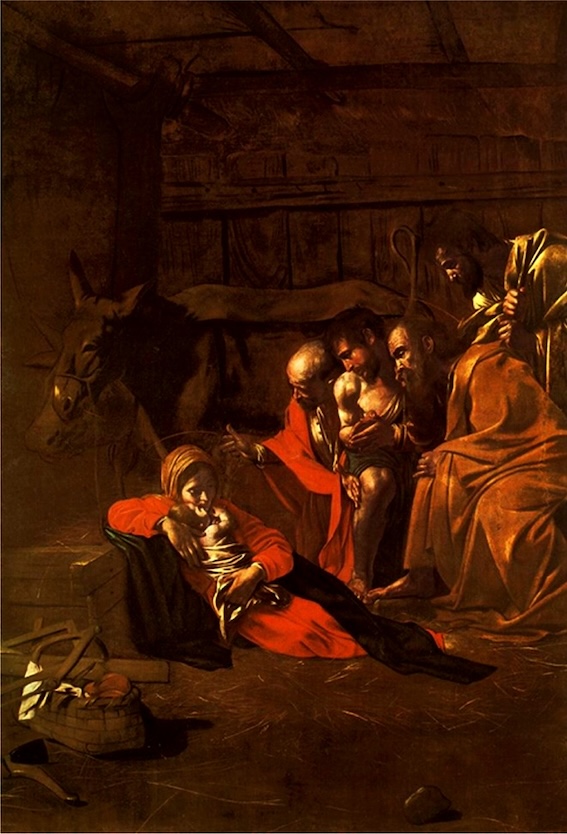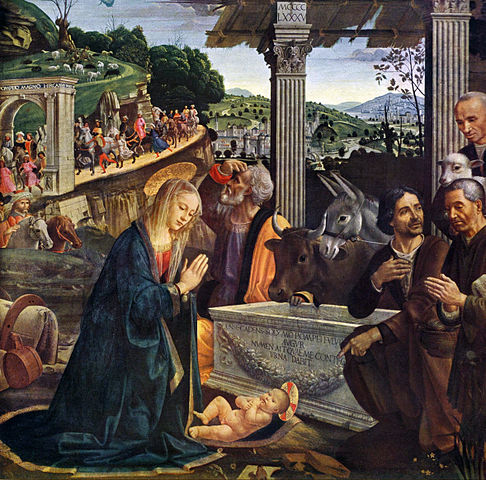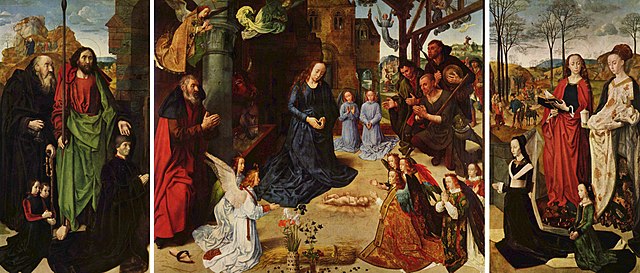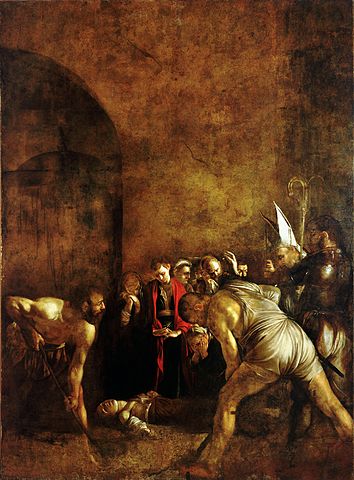Adoration of the Shepherds by Caravaggio: A Light in the Dark

In late 1608, the famed artist Michelangelo Merisi da Caravaggio absconded to Messina, a city on the northeastern tip of Sicily. On the run from powerful enemies, the city offered him protection, a safe harbor in a turbulent period. Though Caravaggio did not know it at the time, it was here that he would paint some of his final works; among them his Nativity – Adoration of the Shepherds. The piece is a significant departure from earlier depictions of the subject. Gone are the choirs of angels and parade of richly dressed followers typical of Renaissance paintings of the Nativity. In their place is an exhausted Mary, who rests with her child in a dimly lit manger. Surrounding her are haggard men, moved to ecstasy by the event unfolding before them. The piece offers a vision of dignified poverty; a quiet simplicity that resonates with humility and love. In completing Adoration of the Shepherds for the city of Messina, Caravaggio secured his legacy in Sicily, where memories of his visit would be talked about for centuries afterwards.
Table of Contents
Style – A Dark Manger
Adoration of the Shepherds is considered by some to be Caravaggio’s best work. In it, he realizes the full potential of the painting techniques honed over his short life. First and foremost is Caravaggio’s use of light. As in his earlier works, Caravaggio uses a high light-dark contrast (chiaroscuro) to add to the drama of the scene. The light in this picture appears to originate somewhere to the left of the painting, perhaps from a lantern. The light shines harshly on his figures, leading one’s eyes diagonally from Mary and her infant to Joseph and the shepherds. The light both focuses you on these individuals and isolates them. Surrounding the figures is the dark outlines of the manger. Unlike in some of his earlier works, this backdrop, though dark, remains fully visible. Caravaggio wants you to see the manger, which becomes the humble backdrop for Christ’s miraculous birth.
Lighting aside, the other stylistic element worth noting is the naturalism (or realism) of the piece. Unlike earlier depictions of the Nativity, there are no choirs of angels or crowds of richly dressed followers. Half the canvas is just the dark outlines of the manger. The rest of the painting is occupied by a cast of seemingly ordinary people. Mary rests against a feeding trough, weakened from child birth. Joseph and the shepherds look on, bare feet readily visible. In the back, an ox and a donkey munch on some hay, entirely oblivious to the miracle unfolding around them. This naturalistic take on the Nativity was a major break with tradition, one which augured broader changes as art moved away from the Mannerist tradition into the full Baroque.
History – The Nativity Across Time
The Nativity (or birth) of Christ in a manger outside Bethlehem has been a popular subject in art since the earliest days of Christianity. Its depiction, however, has varied greatly over time and geography. By the early Renaissance, the Nativity was portrayed as a bright and glorious event. One version by Fra Angelico and Filippo Lippi is characteristic of these works. Painted in the mid-15th century, this painting shows Mary seated in front of the manger, the infant Christ in her lap. Animals gather around the manger, including a brightly colored peacock perched on the roof. A long trail of followers dressed in bright robes stretches far into the distance, patiently waiting to pay their respects to humanity’s savior. It is an elegant work, a pageant of joy and color reflecting the sentiment of the Gospels, even as the painters took some artistic license with the details.

Another version by Domenico Ghirlandio offers a similar vision. In Ghirlandio’s work, the Virgin Mary appears kneeling in front of the infant Christ, her hands clasped in prayer. A rich, green landscape forms the backdrop, stretching far into the distance. Part of the manger appears to the right. Its pillars look more like a Roman temple than a structure for housing animals. Like in Fra Angelico’s and Lippi’s work, a long trail of individuals, most on horseback, are depicted waiting to pay worship to the son of God. These are just a few representative examples of Renaissance Nativities. Others by Giotto, Botticelli, and Gentile da Fabriano show many similarities. In the context of this tradition, Caravaggio’s painting of an exhausted Mary resting in a dimly lit and rundown manger was a significant break.

There is, however, one notable similarity between Caravaggio’s painting and earlier works – the depiction of the shepherds. Within the bright idealized Renaissance and Mannerist Nativities, the shepherds sometimes appear in a more naturalistic manner – just as in Caravaggio’s work. One example is the late 15th century Portinari Altarpiece done by Flemish painter, Hugo van der Goes. As in other works of the period, this Nativity is a bright and glorious event, in which angels and men alike rejoice. Against this otherwise bright landscape, however, are the shepherds, whose reddish complexion and simple clothing set them apart. Interestingly, the poses adopted by Caravaggio’s shepherds almost precisely mirrors those in van der Goes’s altarpiece, suggesting he had some familiarity with this work or a derivative.

Unlike van der Goes, however, Caravaggio was not content to paint only the shepherds in a naturalistic manner. He extended this treatment to the entire composition, including the holy family. This naturalistic approach runs through all of Caravaggio’s works and was in keeping with the austere values championed by prominent Church leaders of the time. It was especially relevant to the Franciscans, for whom Caravaggio painted Adoration of the Shepherds. It was St Francis himself, who in 1223 erected the first Nativity scene, complete with live animals and a wooden “babe of Bethlehem.” St Francis wanted those who saw the scene to grapple with the Nativity not as an abstraction, but as a real event involving real people. This is exactly what Caravaggio’s painting provides.
Dispensing with the traditional Renaissance and Mannerist embellishments, Caravaggio includes only elements familiar from everyday life. Gone are the choirs of angels and richly dressed followers. In their place, we see an image of dignified poverty, evident in the rough walls of the manger and the ruddy complexion and dirty feet of the shepherds. This image of holy poverty, a central element of Franciscan spiritual practices, resonated with the friars. According to one of Caravaggio’s early biographers, the Franciscan friars so adored this work that they made a special appeal to the city senate to recognize them as the sole custodians of the painting, thus frustrating attempts by local aristocrats to seize it.
Themes and Symbolism – Poverty and Personality
As suggested above, the most prominent theme in Caravaggio’s Adoration of the Shepherds is its depiction of the Holy Family’s poverty. The rough construction of the manger, the dirty feet of the shepherds, and the still life of Joseph’s carpentry tools all hint at this. Most striking is the depiction of Mary. Unlike Fra Angelico’s and Lippi’s work, Mary is not seated like a monarch presiding over her court, but rather as a tired (though happy) mother, exhausted from her recent labor.
It is perhaps this which makes the piece especially beloved amongst Caravaggio’s other works. Renaissance depictions of the Nativity, with their angels and richly dressed followers, seem to be happening in a world far away. Caravaggio’s work is far more relatable, occurring within a setting familiar to an ordinary peasant or laborer. To those among the poor who saw it, the painting suggests that the presence of the divine can be found even in the humblest of circumstances.
The outward signs of poverty aside, art historian and Caravaggio biographer Andrew Graham-Dixon also sees evidence of a more personal side to the painting. He notes that in the composition, Mary sits alone with her child, apart from Joseph and the shepherds. No longer do the shepherds hover near her, kissing the foot of Christ as they do in other works. Graham-Dixon speculates that this may be reflective of Caravaggio’s own childhood. Caravaggio lost his father and other adult male relatives during a plague when he was five. Thus, to Caravaggio, mother and child were always separate. They shared a special relationship, entirely divorced from the world of men. From this vantage point, it is not surprising that Caravaggio would give special treatment to the relationship between mother and child, which to him, may have stood above all else.
Related Works
As with Adoration of the Shepherds, other paintings done by Caravaggio during his time in Sicily show a similar presentation of religious imagery. His most notable works from this time period are The Raising of Lazarus and Burial of St Lucy. These are among Caravaggio’s final works, done just a year or two before his death.
Like Adoration of the Shepherds, The Raising of Lazarus was also painted in Messina. Caravaggio supposedly worked on this painting from a studio set up in a hospital. Rumor has it that he had some of the hospital workers hold actual cadavers for him to paint from. He is even said to have lashed out at the workers when, due to the stench, they shifted position. Some believe this story to be apocryphal but this is in fact what is being depicted in the painting – a group of people holding up a dead body. The corpse itself appears wretched – discolored and decomposing. Christ stands before the corpse, reaching out toward it; commanding Lazarus to rise. Others look on in anticipation, still uncertain as to whether Christ will be able to pull off this miracle. Hope, doubt, and faith, are visible in their faces, which lie at the core of this electrifying painting.

Burial of St Lucy is another of Caravaggio’s surviving Sicilian works. According to the Golden Legend, St Lucy converted to Christianity during a time when the religion was still outlawed by Syracuse’s Roman authorities. Denounced by her husband, the local magistrate gave her over to a crowd to do with her as they wished. Protected by God, her would be tormentors were unable to harm her. After attempting all manner of torment, St Lucy finally succumbed to a sword wound, but only after she requested and was allowed to take Holy Communion.

As with The Raising of Lazarus, death is a central theme. St Lucy’s lifeless corpse lays unglamorously at the bottom of the painting. A crowd of mourners gather behind her while two workman dig her grave in the foreground. The workmen appear impossibly large, dominating the painting. Their cold demeanor as they go about their work contrasts with the emotion of the crowd behind them. The painting, like the story, pits the soft against the hard; the weak against the strong. It’s a central element of Christ’s teachings, which Caravaggio expertly captures in his somber depictions.
Final Thoughts on Adoration of the Shepherds by Caravaggio
Caravaggio’s Adoration of the Shepherds would be a beautiful painting even if the child were not Christ. It is as much a celebration of motherhood as it is religious veneration. The way the infant Christ reaches up playfully towards Mary’s exhausted face is especially relatable and endearing. Sadly, Adoration of the Shepherds is one of Caravaggio’s last works. He would die the following year at the age of 39. Had he lived a few decades longer, he might have seen a Rome fully embrace the Baroque tradition of which he was a forerunner. In so doing, he might be remembered today as an artist on par with Renaissance masters like Raphael, Botticelli, and (his namesake) Michelangelo. Perhaps then, more effort would have been made to preserve the records and memories of the key events of his life. Absent that, we can only speculate what might have motivated his revolutionary approach to painting, which continues to resonate over four centuries after his death.
Sources/Further Reading on Adoration of the Shepherds by Caravaggio
- For more information on Caravaggio, see this post on the Caravaggio’s life and most famous paintings.
- Read more about naturalism in the art of Caravaggio in this post on Basket of Fruit.
- For more on light, shadow, and despair in the art of Caravaggio, see this post on the artist’s David and Goliath.
- For more on faith in the art of Caravaggio, see this post on the artist’s Sacrifice of Isaac.
- Chorpenning, Joseph F. “Another Look at Caravaggio and Religion.” Artibus et Historiae, vol. 8, no. 16, IRSA s.c., 1987, pp. 149–58
- Graham-Dixon, Andrew. “Caravaggio: A Life Sacred and Profane.” Allen Lane and Penguin Books. London. 2010
- I found this piece by Tom McCarthy to be a nice take on the painting.
- For further history on St Francis’s Nativity, see this piece in Slate.

